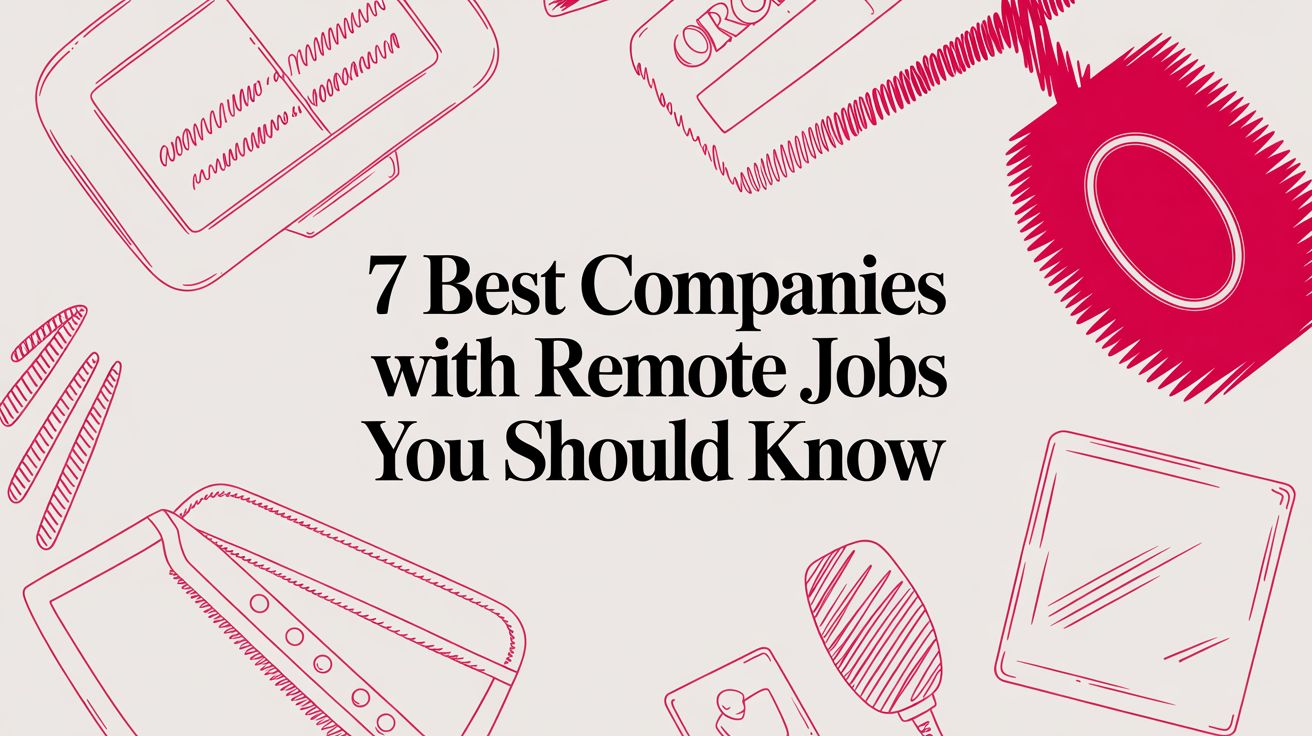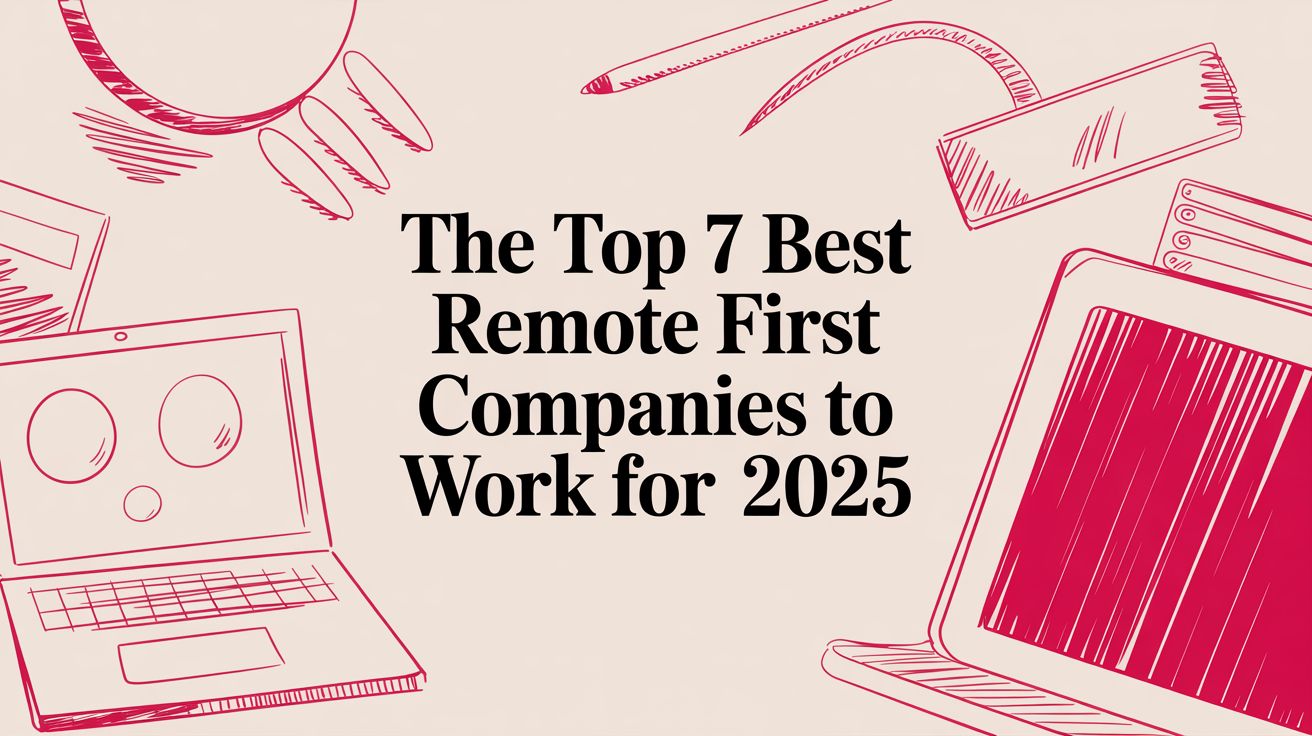Top 7 Best Remote Healthcare Companies to Work For in 2024
Max
The healthcare industry has undergone a seismic shift, with remote work moving from a niche perk to a core operational model. This transformation offers unprecedented flexibility and new opportunities for professionals across a spectrum of clinical, administrative, and technology-focused roles. For job seekers, this new paradigm presents a challenge: navigating a crowded field to find employers that not only offer remote positions but also foster a supportive and innovative culture.
This guide cuts through the noise to profile the definitive best remote healthcare companies to work for. We move beyond simple job postings to provide an in-depth look at what makes these organizations stand out. For each company featured, you will find actionable insights into their:
- Company Culture: What is it really like to work there?
- Roles Offered: From telehealth clinicians to software engineers and project managers.
- Unique Benefits: Perks that go beyond standard health insurance and 401(k)s.
- Application Tips: What their hiring managers are looking for.
Whether you are a seasoned nurse practitioner seeking a flexible telehealth schedule, a data analyst passionate about health outcomes, or an IT specialist looking to innovate, this roundup is your roadmap. Understanding the technological backbone of these roles is also crucial. To understand the infrastructure supporting remote roles, exploring how companies implement managed IT services for healthcare provides valuable insight into the operational landscape. Our goal is to equip you with the detailed information needed to find a remote career that doesn’t just pay the bills but truly nurtures your professional growth and aligns with your long-term goals. Let’s dive into the companies leading the charge in remote healthcare.
1. FlexJobs
While not a direct employer, FlexJobs earns its top spot as a premium platform for finding the best remote healthcare companies to work for. It’s a subscription-based job board that meticulously hand-screens every single posting to ensure legitimacy and relevance. This curation process eliminates the spam, scams, and poorly classified “remote” jobs often found on larger, free aggregators, making it an invaluable tool for serious healthcare professionals.

The platform specializes in connecting professionals with legitimate flexible work arrangements, including fully remote telehealth, clinical informatics, medical coding, case management, and health IT roles. Its powerful, healthcare-specific filtering tools allow you to narrow your search by job type (employee, freelance), schedule (full-time, part-time), and career level, saving you significant time and effort.
Why It Stands Out
FlexJobs differentiates itself with a “quality over quantity” approach. Every company and job listing is vetted by a human research team. This commitment to quality means that when you find a remote healthcare position on FlexJobs, you can trust it’s a real, professionally-vetted opportunity.
Key Insight: The true value of FlexJobs lies in its role as a high-quality filter. By paying a small subscription fee, you gain access to a curated database that respects your time and protects you from fraudulent listings that are increasingly common on free job boards.
Using FlexJobs Effectively
To maximize your subscription, go beyond simple keyword searches.
- Set Up Detailed Job Alerts: Create multiple, highly specific alerts for roles like “remote RN case manager” or “telehealth psychiatric nurse practitioner.” Let the curated jobs come directly to your inbox.
- Utilize Career Resources: Your membership includes access to skills tests, expert webinars, and personalized career coaching, all designed to sharpen your remote job search strategy.
- Research Company Profiles: Explore the detailed company profiles on FlexJobs. They often include an overview of the company’s remote work history and benefits, helping you identify organizations that are truly committed to remote culture. This is a crucial step in finding the best remote healthcare companies to work for.
Subscription and Access
FlexJobs operates on a subscription model, which is essential to its ad-free, high-quality service. Pricing is structured in tiers, offering flexibility based on your needs.
| Subscription Tier | Cost (as of late 2023) |
|---|---|
| 1 Week | $2.95 (Trial Rate) |
| 1 Month | $24.95 |
| 3 Months | $39.95 |
| 1 Year | $59.95 |
The platform also offers a satisfaction guarantee, providing a refund if you’re not satisfied within 30 days. This makes trying the service a low-risk investment in your career search. With its dedicated focus on remote work and robust vetting process, FlexJobs is an essential first stop. You can explore more details by reading about the top remote job websites.
2. Remote.co (Healthcare Jobs)
Remote.co is a highly respected resource in the remote work community, offering a dedicated and curated job board specifically for healthcare professionals. Unlike massive job aggregators, it focuses exclusively on remote opportunities, providing a clean, straightforward platform to find roles in clinical telehealth, care coordination, behavioral health, and health tech. The site is known for its high-quality listings and user-friendly interface.
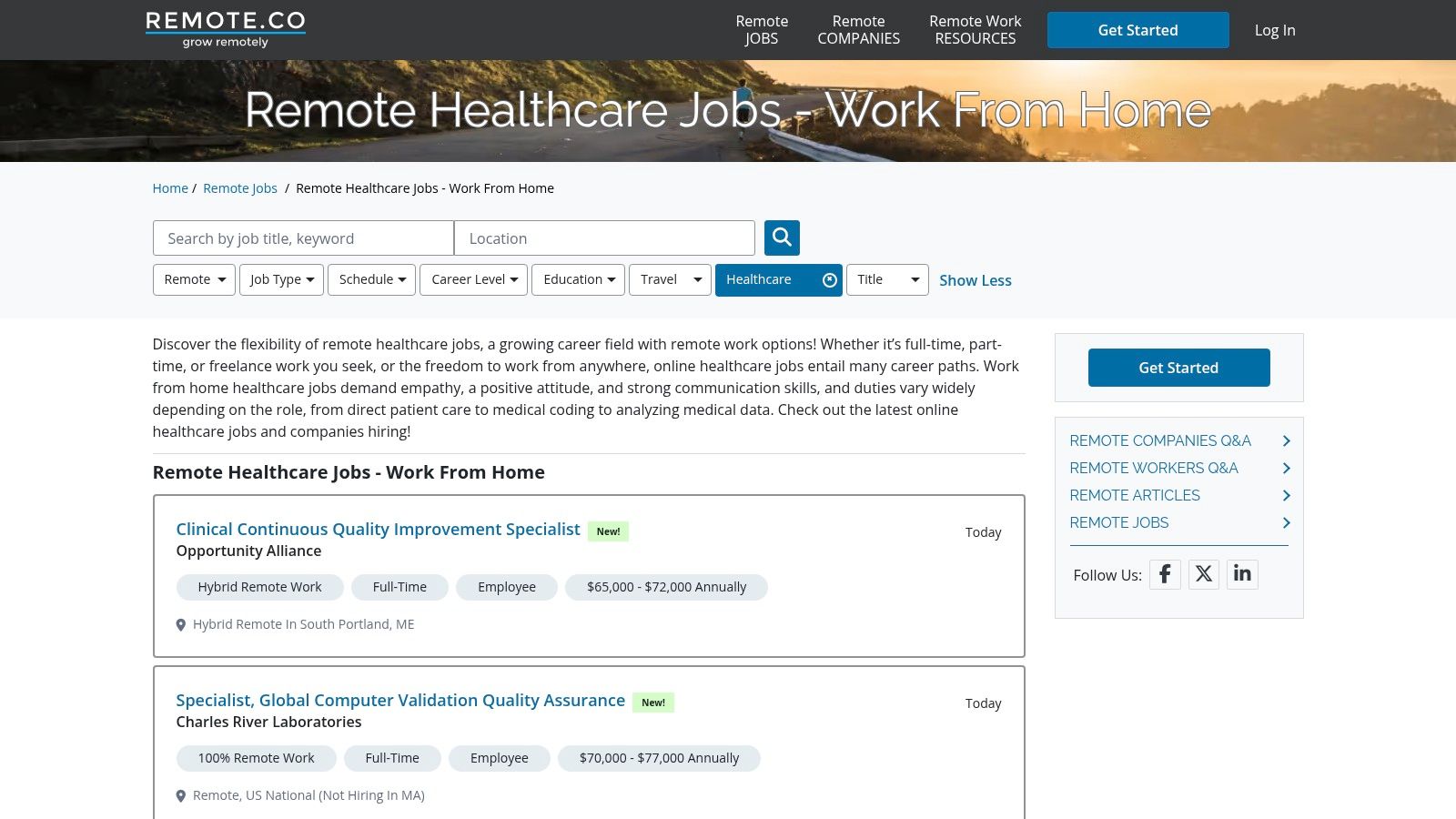
The platform’s strength lies in its simplicity and clarity. Each job posting is clearly tagged to indicate its remote status (100% remote vs. hybrid), schedule requirements, and sometimes even pay ranges. This transparency allows job seekers to quickly scan and identify suitable positions without digging through irrelevant information, making it an efficient tool for finding genuinely remote healthcare roles.
Why It Stands Out
Remote.co distinguishes itself by providing free, direct access to high-quality, pre-vetted remote healthcare job listings. There’s no subscription fee or mandatory account creation, removing barriers for job seekers. The focus on a single niche ensures that the listings are relevant and up-to-date, with fresh postings appearing frequently from some of the best remote healthcare companies to work for.
Key Insight: Remote.co acts as a powerful, no-cost gateway to legitimate remote healthcare careers. Its minimalist design and clear labeling system prioritize the user’s time, making the job search process less about volume and more about targeted, high-quality opportunities.
Using Remote.co Effectively
To get the most out of this free resource, a targeted approach is key.
- Check Daily for New Postings: The healthcare section is updated frequently. Make it a habit to check the site daily to catch new opportunities as soon as they are posted.
- Use Specific Keywords: Combine your role with remote-specific terms. For example, search for “remote telehealth therapist” or “virtual medical scribe” to narrow down the results effectively.
- Explore Company Q&As: Remote.co features insightful Q&A sections with leaders from remote-first companies. These articles provide a valuable look into company culture and hiring practices, helping you tailor your application.
Subscription and Access
One of the most significant advantages of Remote.co is its access model. The platform is completely free for job seekers, ensuring everyone can benefit from its curated listings.
| Feature | Cost |
|---|---|
| Browsing Job Listings | Free |
| Applying to Jobs | Free (Direct to employer) |
| Accessing Company Articles | Free |
| Account Creation | Not Required |
There are no hidden fees or premium tiers. You can browse and apply for jobs by clicking directly on the posting, which redirects you to the employer’s official application page or Applicant Tracking System (ATS). This direct, transparent approach makes Remote.co an essential and risk-free tool in your job search arsenal.
3. LinkedIn Jobs (Remote Healthcare)
As the world’s largest professional network, LinkedIn has evolved into a powerhouse for job searching, and its remote healthcare sector is no exception. It combines a massive, constantly updated job board with unparalleled networking capabilities, allowing you to not just find openings but also connect with the people and companies behind them. This integration makes it a dynamic tool for a proactive job search in the healthcare industry.
The platform is a go-to for recruiters, meaning you’ll find a vast inventory of telehealth, clinical research, health administration, and medical billing roles directly from employers. Its powerful search filters let you specify “Remote” and even filter by state or nationwide eligibility, which is critical for licensed healthcare professionals. You can also leverage company pages to research potential employers and see if you have any connections who already work there.
Why It Stands Out
LinkedIn’s unique advantage is the seamless blend of job searching and professional networking. Unlike traditional job boards where you simply apply and wait, LinkedIn encourages you to research the hiring manager, explore the company’s culture through employee posts, and even reach out to recruiters directly. This active approach can significantly increase your visibility and help you find the best remote healthcare companies to work for.
Key Insight: LinkedIn transforms your job search from a passive activity into an active networking campaign. The ability to see who posted a job, who works at the company, and what the company culture looks like provides invaluable intelligence that no other platform can match.
Using LinkedIn Effectively
To get the most out of LinkedIn, you need to use it as more than just a job board.
- Optimize Your Profile: Ensure your profile is rich with keywords relevant to your healthcare specialty (e.g., “telemedicine,” “RN,” “clinical informatics”). Treat your headline and summary as your personal brand statement.
- Engage with Target Companies: Follow the companies you’re interested in, engage with their posts, and connect with their recruiters and talent acquisition specialists. This keeps you on their radar.
- Use Advanced Search and Alerts: Save highly specific job searches like “remote licensed clinical social worker” or “part-time telehealth physician assistant” and set up daily alerts to be the first to know about new opportunities.
Subscription and Access
LinkedIn offers a robust free version that is sufficient for most job seekers. However, LinkedIn Premium provides additional features that can accelerate your search.
| Feature | Free Version | LinkedIn Premium (Career) |
|---|---|---|
| Job Search | Yes, with standard filters | Yes, with enhanced filters and “Top Applicant” insights |
| Profile Views | See the last 5 people who viewed your profile | See everyone who viewed your profile in 90 days |
| InMail Messages | No (must be connected) | 5 InMail credits per month to message anyone |
| Applicant Insights | Limited | See how you compare to other applicants |
The free version provides full access to job listings and networking, making it a powerful tool without any cost. For those wanting an edge, the Premium Career subscription (around $29.99/month) can be a worthwhile investment. This platform is essential for anyone serious about finding the right role and understanding the modern landscape of the best careers for working remotely.
4. Indeed
As one of the world’s largest job aggregators, Indeed is a powerhouse for discovering a massive volume of remote healthcare positions. It casts a wide net, pulling in listings from direct employer career pages, staffing agencies, and smaller job boards, making it a comprehensive starting point for any remote healthcare job search. Its sheer scale means you can find everything from telehealth nursing and medical billing to niche health tech and clinical research roles.
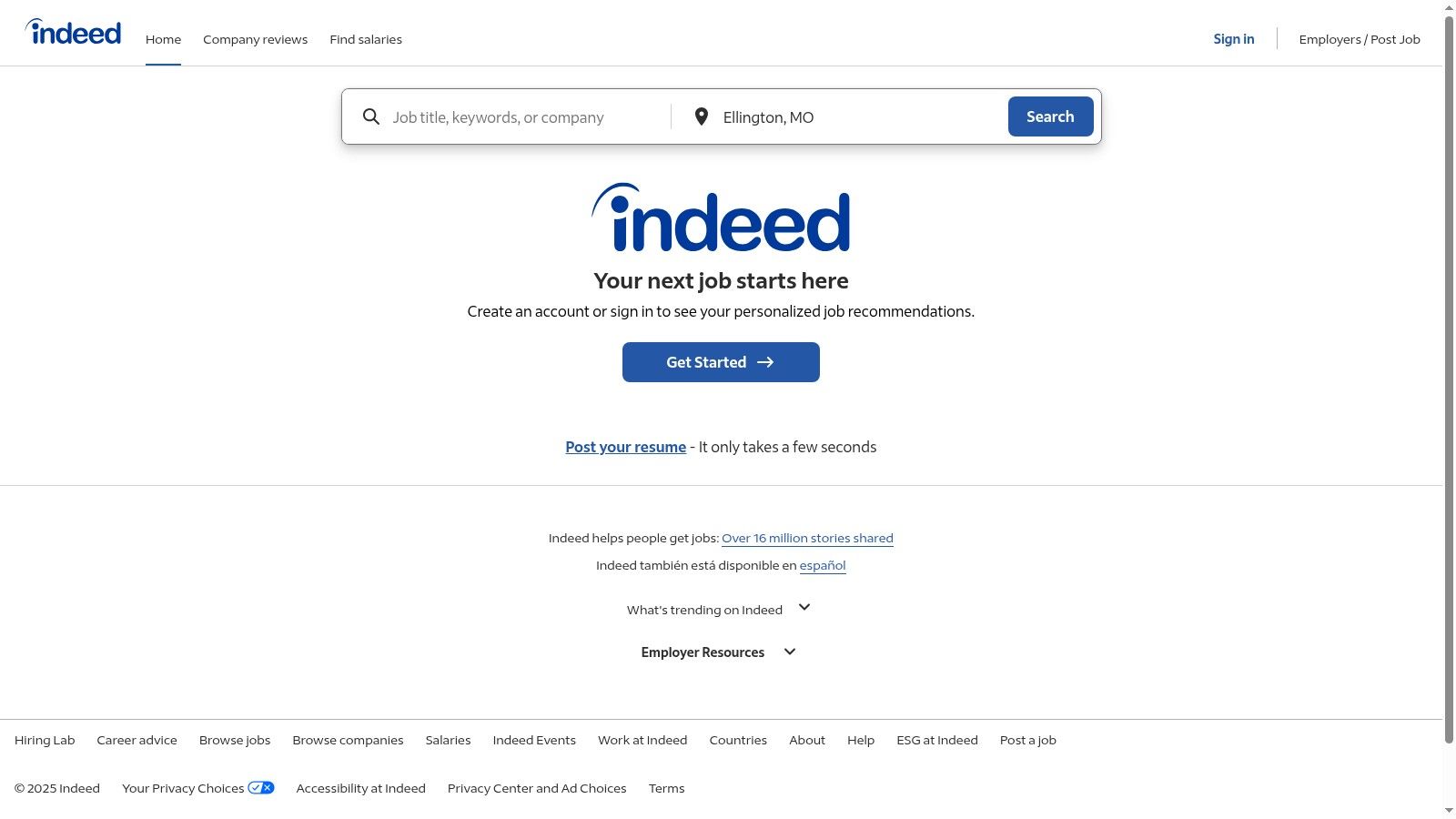
The platform is renowned for its straightforward search functionality and powerful filters that allow you to specify “remote” or “work from home” along with healthcare-specific keywords. Many listings include estimated salary ranges, company reviews, and Q&A sections, providing valuable context that helps you evaluate potential employers and understand market pay bands before you even apply.
Why It Stands Out
Indeed’s primary advantage is its unmatched volume and breadth. While curated sites offer quality, Indeed offers quantity, which is crucial for market research and uncovering less-publicized opportunities. You can quickly get a sense of which companies are hiring aggressively for remote healthcare roles, what skills are in demand, and what compensation to expect across different sub-specialties.
Key Insight: Indeed excels as a market research tool. Its vast database allows you to compare numerous employers, salary ranges, and job descriptions side-by-side, giving you a powerful, data-driven perspective on the remote healthcare job market that smaller, niche platforms cannot match.
Using Indeed Effectively
To cut through the noise and find high-quality roles, a strategic approach is necessary.
- Master Advanced Search: Use Boolean operators in your searches. For example, use
"remote clinical trial associate" -managerto find non-managerial roles and exclude irrelevant results. - Leverage Company Pages: Once you identify a promising company, visit its dedicated page on Indeed. Read employee reviews, check salary data, and see all their current openings to get a holistic view of their culture and hiring needs.
- Set Up Precise Job Alerts: Create highly specific alerts for your target roles, such as “remote utilization review nurse” or “telehealth medical assistant.” This automates your search, ensuring you’re among the first to see new, relevant postings from the best remote healthcare companies to work for. Learning more about this is a key step in understanding how to find remote jobs.
Subscription and Access
Indeed is a completely free platform for job seekers. There are no subscription fees or hidden costs to search for jobs, upload your resume, or apply for positions. This barrier-free access makes it an essential and accessible tool for everyone in the healthcare field.
| Feature | Cost |
|---|---|
| Job Searching | Free |
| Resume Upload | Free |
| Job Alerts | Free |
| Applying to Jobs | Free |
The platform’s business model relies on employers paying to post jobs or sponsor listings for greater visibility. This free access, combined with its immense database, solidifies Indeed’s position as a fundamental resource for any comprehensive remote healthcare job search strategy.
5. Glassdoor
While not a direct job board in the traditional sense, Glassdoor is an indispensable research tool for anyone vetting the best remote healthcare companies to work for. It provides a transparent, behind-the-scenes look at company culture, salaries, and employee satisfaction through millions of anonymous reviews. This makes it an essential checkpoint before you invest time in applying for a remote healthcare role.
Glassdoor’s power lies in its user-generated content. You can read detailed reviews from current and former employees, find salary data for specific roles like “Telehealth Nurse Practitioner,” and even get insights into the interview process. This information is critical for determining if a company’s advertised remote-friendly culture is a reality or just a marketing tactic.
Why It Stands Out
Glassdoor’s unique value is its focus on workplace transparency. While other platforms show you the job listings, Glassdoor shows you what it’s really like to work there. Its annual ‘Best Places to Work’ awards often feature healthcare and biotech companies, giving you a pre-vetted list of top-tier employers to start your research with. For remote job seekers, this intel is gold.
Key Insight: Use Glassdoor not just to find jobs, but to validate opportunities found elsewhere. A promising remote role at a company with consistently poor reviews about work-life balance or management support is a major red flag that other job boards won’t reveal.
Using Glassdoor Effectively
To get the most out of the platform, you need a strategic approach.
- Filter for Remote-Specific Insights: When reading reviews, use keywords like “remote,” “telework,” “work from home,” or “WFH” in the search bar within a company’s profile. This helps you find reviews that specifically mention the remote employee experience.
- Analyze Salary Data by Location: Compare the salary data for your target role against national averages and your local cost of living. This empowers you during salary negotiations, ensuring you receive fair compensation for your remote position.
- Study Interview Questions: The “Interviews” section provides real questions asked during the hiring process for specific healthcare roles. Use this to prepare thoroughly and walk into your virtual interview with confidence. This is a key step in securing a position with the best remote healthcare companies.
Subscription and Access
Glassdoor offers its vast database of reviews and salary information for free. However, there’s a “give-to-get” model in place to ensure a steady stream of fresh, authentic content.
| Access Level | Cost | Requirements |
|---|---|---|
| Limited View | Free | No sign-in required, but access is restricted. |
| Full Access | Free | Sign up and contribute an anonymous review. |
| Job Seeker | Free (for job ads) | Browse and apply for jobs without restriction. |
To unlock unlimited access to all reviews, salaries, and interview insights, you must create a free account and contribute anonymously by posting a salary, a company review, or interview feedback. This model maintains the platform’s integrity and ensures the data remains relevant and user-powered. You can start your research at Glassdoor.
6. Great Place to Work (Fortune Best Workplaces in Health Care)
Instead of being a job board, Great Place to Work serves as an indispensable research tool for identifying top-tier employers. It publishes Fortune’s highly respected list of the Best Workplaces in Health Care, which is based on rigorous, confidential employee surveys. This data-driven approach allows you to build a target list of companies known for exceptional culture, employee satisfaction, and trust before you even start looking for specific job openings.
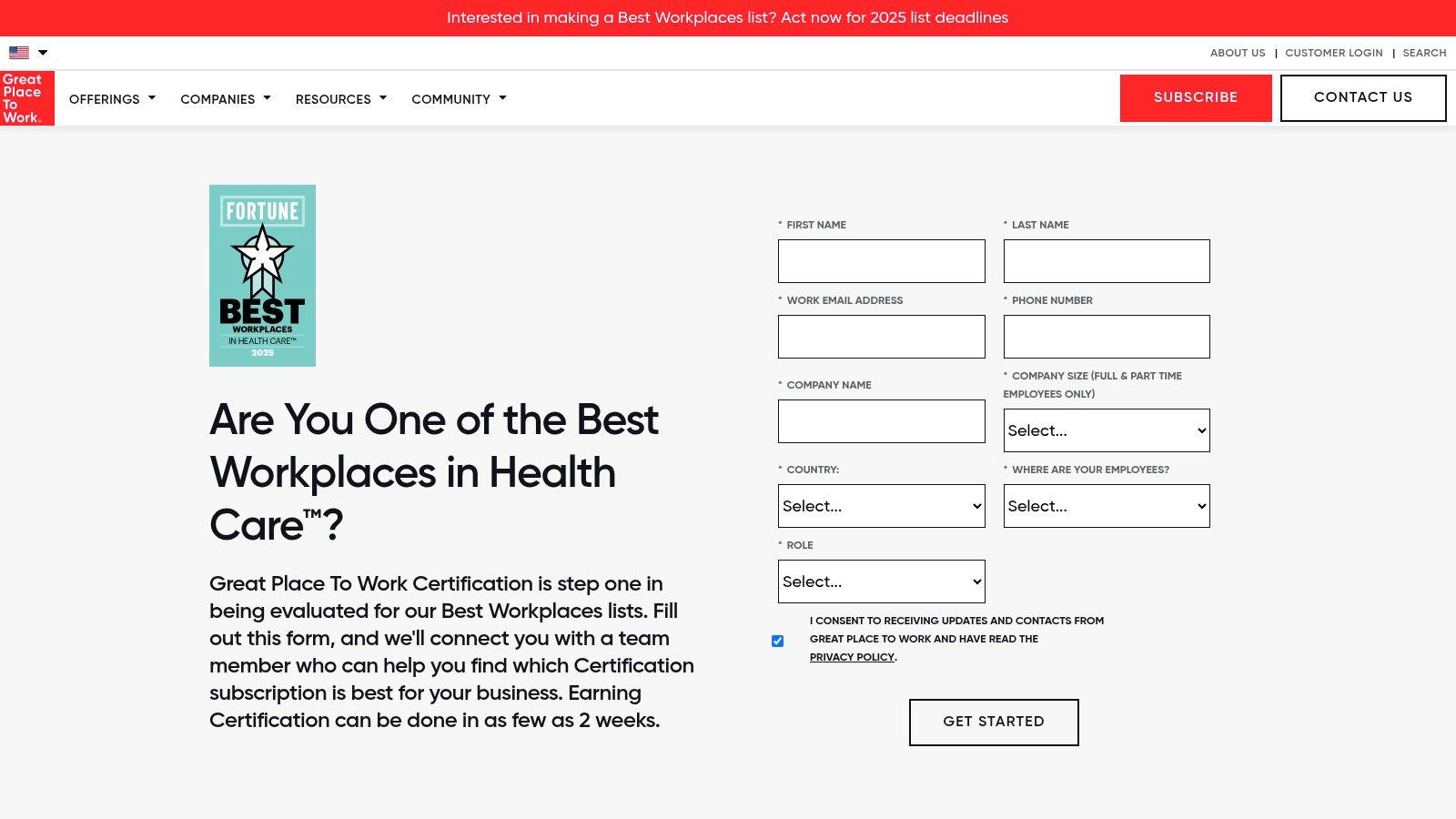
The platform features detailed profiles for recognized employers across the healthcare spectrum, including payer, provider, staffing, and digital health organizations. While the lists themselves are not remote-specific, many of the honored companies have robust remote work policies. By starting your search here, you prioritize culture fit and employee experience, increasing your chances of finding a fulfilling long-term role.
Why It Stands Out
Great Place to Work stands apart by offering validated, third-party proof of a positive work environment. While any company can claim to have a great culture, earning a spot on this list requires high marks from its own employees. This level of verification provides a powerful signal to job seekers, saving you from wasting time on companies with a poor internal track record.
Key Insight: This platform shifts the job search paradigm. Instead of sifting through thousands of job descriptions, you start by identifying companies validated for their outstanding employee experience and then investigate their remote career opportunities. This “company-first” strategy is a highly effective way to find the best remote healthcare companies to work for.
Using Great Place to Work Effectively
To get the most value from this free resource, use a strategic, research-focused approach.
- Build a Target List: Review the “Best Workplaces in Health Care” lists for both large and small/medium companies. Create a spreadsheet of 10-15 companies that align with your career goals.
- Investigate Company Profiles: Click through to each company’s profile on the Great Place to Work website. From there, navigate directly to their official career pages to search for remote or hybrid positions.
- Set Up Alerts for Target Companies: Once you have your list, use LinkedIn or other job boards to set up alerts specifically for remote jobs at those target companies. This ensures you’re among the first to know when a role opens up at a top-rated employer.
Subscription and Access
Access to all lists and company profiles on Great Place to Work is completely free for job seekers. You can browse the rankings, read detailed profiles, and link out to company websites without any subscription or sign-up required. The business model is based on companies paying for the certification process, making it a valuable and accessible tool for professionals conducting due diligence on potential employers. By starting your research with validated data, you can build a more intentional and successful job search. You can explore a broader list of top employers in our guide to the best companies for remote jobs.
7. Wheel (Telehealth Clinician Network)
Wheel operates as a specialized platform built to connect clinicians with high-quality telehealth opportunities. Instead of functioning as a direct employer, it acts as a centralized network that matches physicians, nurse practitioners (NPs), registered nurses (RNs), and behavioral health specialists with a variety of partner companies. This model streamlines the entire process of finding and engaging in remote clinical work.
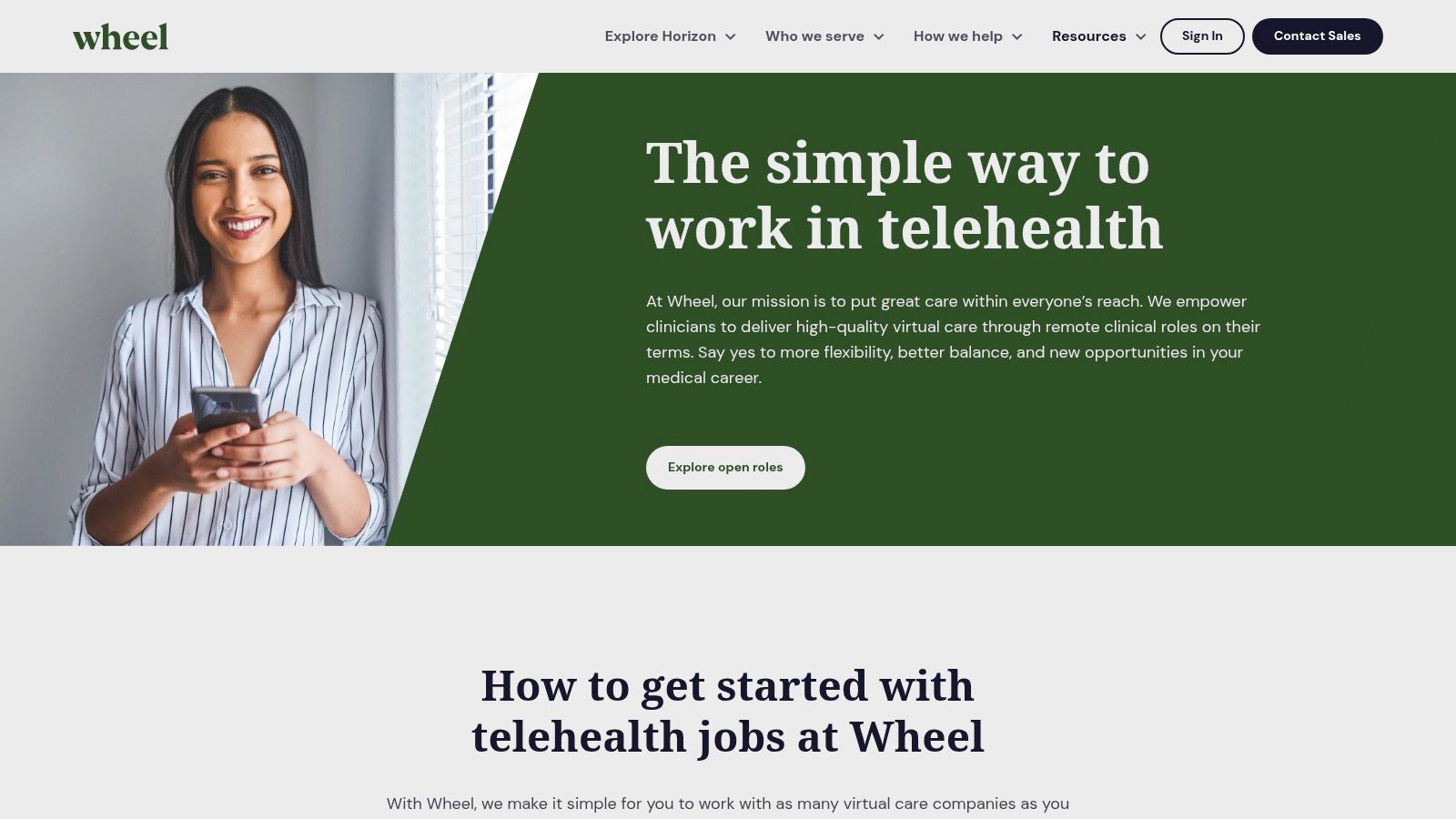
The platform significantly reduces the administrative burden typically associated with locum tenens or multi-client contract work. Clinicians go through a single credentialing process and sign one contract, which then gives them access to work with multiple vetted telehealth brands. This allows professionals to diversify their practice across urgent care, primary care, behavioral health, and remote patient monitoring without repetitive paperwork.
Why It Stands Out
Wheel is purpose-built from the ground up for the modern clinician seeking flexible, remote work. Its core innovation lies in the centralized credentialing and contracting system. This “work with one, work with many” approach is a game-changer, eliminating a major pain point for clinicians who want to work with several telehealth companies simultaneously.
Key Insight: Wheel’s true value is its role as a career management platform, not just a job board. It simplifies the business side of telehealth, allowing clinicians to focus on patient care while maintaining flexibility and control over their schedules. This unique infrastructure makes it one of the best remote healthcare companies to work for if you are a licensed clinician.
Using Wheel Effectively
To get the most out of the platform, clinicians should think strategically about building their telehealth practice.
- Highlight Your Licenses: Ensure your profile accurately reflects all your active state licenses. Wheel’s matching algorithm prioritizes clinicians licensed in states with high patient demand from their partners.
- Embrace Flexibility: Be open to both synchronous (live video) and asynchronous (store-and-forward) care opportunities. This increases your potential match rate and earning potential.
- Complete the Training: Take advantage of Wheel’s training modules, which cover best practices for “webside manner” and platform-specific workflows. This demonstrates your commitment and prepares you for success.
Access and Onboarding
Accessing opportunities through Wheel is free for clinicians, as the platform’s revenue comes from its corporate partners. The process involves a comprehensive application and vetting procedure.
| Stage | Description |
|---|---|
| Application | Submit your professional history, licenses, and certifications. |
| Vetting | A thorough review of your credentials and a virtual interview. |
| Credentialing | Wheel’s team handles the credentialing process for its network of partners. |
| Onboarding | Training on the Wheel platform and an introduction to available opportunities. |
While the platform is highly beneficial, opportunities are primarily for licensed clinical roles, with limited options for non-clinical professionals. The availability of work can also depend heavily on your specific license type and state regulations. If you’re a nursing professional, you can find more information about this type of work by exploring remote nursing jobs. You can get started by visiting the Wheel for Clinicians website.
Top 7 Remote Healthcare Job Platforms Comparison
| Platform | Implementation Complexity 🔄 | Resource Requirements ⚡ | Expected Outcomes 📊 | Ideal Use Cases 💡 | Key Advantages ⭐ |
|---|---|---|---|---|---|
| FlexJobs | Moderate: subscription setup and filters | Paid subscription; curated job screenings | High-quality, vetted remote healthcare roles | Remote/hybrid healthcare job seekers needing scam-free listings | Curated, low spam; career resources; reliable |
| Remote.co (Healthcare Jobs) | Low: free, simple browsing | Free access; no account needed | Fresh, niche remote healthcare job listings | Job seekers wanting up-to-date, clearly tagged healthcare roles | Healthcare focus; easy, free access |
| LinkedIn Jobs (Remote Healthcare) | Moderate-High: account setup, networking | Free with optional Premium; networking tools | Vast job inventory with networking opportunities | Professionals targeting top healthcare employers and networking | Massive listings; integrated networking |
| Indeed | Low: easy to start, no signup required | Free access; resume upload optional | Broad market coverage including niche roles | Comprehensive remote healthcare job search with salary data | Huge volume; salary insights; frequent updates |
| Glassdoor | Low-Moderate: needs account for full access | Free account for reviews and salaries | Deep company insights and remote culture vetting | Candidates vetting company culture before applying | Employee reviews; salary & interview insights |
| Great Place to Work | Low: browse rankings site | Free access to company lists | Trusted company culture validation | Building employer target lists based on trustable rankings | Validated culture rankings; time-saving |
| Wheel (Telehealth Clinician Network) | Moderate: specialized clinical onboarding | License, credentialing centralized | Streamlined clinical telehealth job placement | Clinicians seeking telehealth roles with less admin burden | Centralized credentialing; reliable clinical roles |
Your Next Step: Building a Fulfilling Remote Healthcare Career
Embarking on a job search in the digital health space can feel overwhelming, but armed with the right tools and strategies, you can navigate this landscape with confidence. The platforms and companies we’ve explored, from comprehensive job boards like LinkedIn and Indeed to specialized networks like Wheel, all offer unique pathways to finding the best remote healthcare companies to work for. This journey isn’t just about finding a job; it’s about strategically building a career that aligns with your professional goals and personal values in a rapidly evolving industry.
As you’ve seen, each tool serves a distinct purpose. FlexJobs offers a curated, scam-free environment, while Glassdoor provides invaluable, transparent insights into company culture and compensation. The key is to create a multifaceted approach rather than relying on a single source.
Synthesizing Your Strategy: From Research to Application
The most successful job seekers don’t just browse; they build a comprehensive strategy. Your next steps should focus on turning the information you’ve gathered into tangible action.
- Create a Master Profile: Synthesize your research into a “master profile” of your ideal remote healthcare company. What are your non-negotiables? Consider factors like company size, mission, patient care model (e.g., synchronous vs. asynchronous), and the specific technologies they use.
- Segment Your Search: Use different platforms for different goals. For instance, leverage LinkedIn for networking and following target companies, use FlexJobs for applying to pre-vetted roles, and consult Great Place to Work lists to discover employers renowned for their culture.
- Tailor Your Materials: Generic applications get lost in the digital shuffle. For each application, customize your resume and cover letter to mirror the language in the job description. Highlight specific remote work skills like asynchronous communication, self-discipline, and proficiency with collaboration tools (e.g., Slack, Asana, EMR systems).
Beyond the Application: Aligning with Company Culture and Mission
Finding the right fit extends far beyond matching your skills to a job description. The most fulfilling roles are found where your personal mission aligns with the company’s vision. A large, established telehealth corporation will offer a different experience than a nimble, growing health-tech firm. When planning your remote healthcare career, consider various types of organizations, including the unique environment of smaller companies. Some professionals thrive in the structured environment of a large enterprise, while others prefer the innovative and agile culture found when exploring opportunities within tiny startups.
Use your research to dig deeper into this alignment:
- Analyze Company Values: Do their stated values on their career page resonate with you? Look for evidence of these values in employee reviews on Glassdoor or in news articles about the company.
- Evaluate Their Digital Presence: How does the company present itself on social media like LinkedIn? Do they celebrate employee achievements, share industry insights, or focus solely on product marketing? This can offer clues about their internal culture.
- Prepare Insightful Questions: During interviews, ask targeted questions based on your research. Instead of asking “What is the company culture like?” try asking, “I saw that one of your company values is ‘patient-centric innovation.’ Can you give me an example of how the clinical team has contributed to a recent product update?”
Your proactive research and thoughtful preparation will not only help you find the best remote healthcare companies to work for but will also position you as a top-tier candidate who is genuinely invested in their future role. The remote healthcare field is brimming with opportunity, and with a strategic, informed approach, your ideal position is well within reach.
Ready to skip the endless searching and connect directly with verified remote-first employers? Remote First Jobs curates the best opportunities from companies that truly understand and support remote work, including many in the healthcare sector. Find your next great role on Remote First Jobs today.
